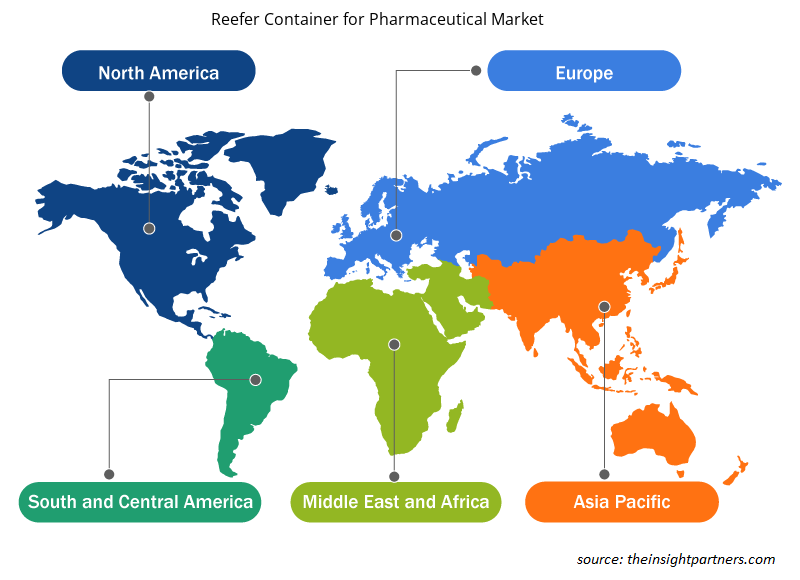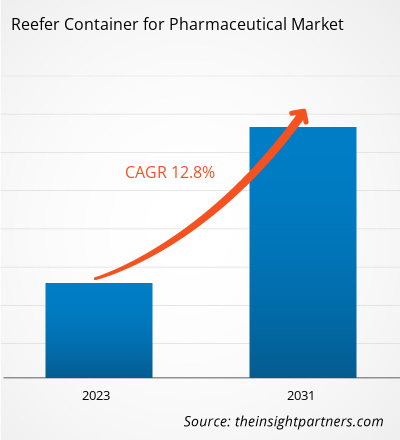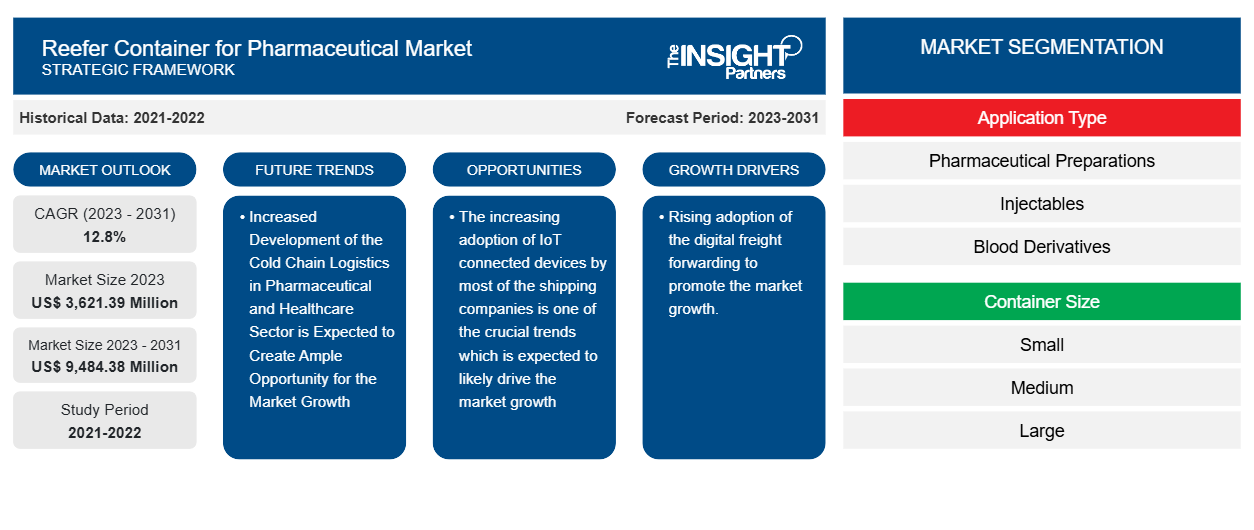Se prevé que el tamaño del mercado de contenedores refrigerados para productos farmacéuticos alcance los 9.484,38 millones de dólares en 2031, frente a los 3.621,39 millones de dólares en 2023. Se espera que el mercado registre una CAGR del 12,8 % durante el período 2023-2031. La creciente adopción de dispositivos conectados a la IoT por parte de la mayoría de las empresas navieras es una de las tendencias cruciales que se espera que impulse el crecimiento del mercado.
Análisis del mercado de contenedores refrigerados para productos farmacéuticos
El análisis del ecosistema de contenedores frigoríficos globales para el mercado farmacéutico incluye depósito, transportista interior, transporte marítimo, transportista, centro de distribución y proveedores o fabricantes de servicios de contenedores frigoríficos. El depósito de contenedores se encarga de todos los servicios necesarios relacionados con los contenedores vacíos, ya sean reparaciones, limpieza, inspección o almacenamiento. El depósito también conserva los productos farmacéuticos para la inspección y el mantenimiento frecuentes de los contenedores frigoríficos, lo que es de vital importancia para todos los involucrados en el proceso de la cadena de suministro de almacenamiento en frío. Los empresarios de transporte terrestre cooperan con otras partes logísticas, como los transportistas, los puertos interiores, los operadores de terminales y los transportistas por carretera, para convertirse en un componente integrado de la cadena. Esta cadena debe organizarse de manera que garantice el uso óptimo de las fortalezas del transporte terrestre, como grandes volúmenes de contenedores, ausencia de problemas de congestión y bajas emisiones de carbono.
Descripción general del mercado de contenedores refrigerados para productos farmacéuticos
El contenedor frigorífico es un contenedor refrigerado utilizado en el transporte intermodal de mercancías en la industria farmacéutica. Es el más utilizado para transportar medicamentos, muestras biológicas para su análisis, vacunas, sangre y derivados. El aumento del comercio internacional y las facilidades de navegación, el menor tiempo de respuesta en las terminales y las perspectivas de crecimiento en el comercio exterior son algunos de los factores destacados que se atribuyen a la demanda de contenedores frigoríficos en la industria farmacéutica, lo que impulsa el crecimiento del mercado. El desarrollo de la tecnología de los contenedores frigoríficos está fortaleciendo aún más la demanda de aplicaciones de cadena de frío. Las unidades refrigeradas farmacéuticas pueden controlar la temperatura de los productos farmacéuticos y permitir que el transportista los controle durante todo el viaje. Estos contenedores también están equipados con tecnología basada en sensores que puede detectar pequeñas variaciones de temperatura e incluso determinar si los productos están expuestos a la luz, lo que podría causar contaminación en ciertos productos farmacéuticos. Los contenedores frigoríficos de alta calidad, generalmente equipados con dispositivos de última generación que controlan las variaciones de temperatura, son ideales para mantener las condiciones óptimas para el envío de productos que pueden deteriorarse, manteniéndolos intactos a pesar de las amenazas externas hasta que llegan a su destino final. Por lo tanto, estos contenedores con características especiales, junto con sensores integrados y dispositivos de monitoreo, aumentan la necesidad de contenedores refrigerados eficientes en la industria farmacéutica, impulsando el crecimiento del mercado.
Personalice este informe según sus necesidades
Obtendrá personalización en cualquier informe, sin cargo, incluidas partes de este informe o análisis a nivel de país, paquete de datos de Excel, así como también grandes ofertas y descuentos para empresas emergentes y universidades.
-
Obtenga las principales tendencias clave del mercado de este informe.Esta muestra GRATUITA incluirá análisis de datos, desde tendencias del mercado hasta estimaciones y pronósticos.
Contenedores refrigerados para el mercado farmacéutico: impulsores y oportunidades
La creciente adopción del transporte de mercancías digital promueve el crecimiento del mercado
La plataforma digital de transporte de carga monitorea y administra continuamente sus envíos en tiempo real, lo que brinda visibilidad a los transportistas. Por lo tanto, la adopción de tecnología avanzada en el transporte de contenedores refrigerados está ayudando a obtener más confiabilidad y eficiencia en el transporte de contenedores refrigerados. El contenedor refrigerado se transporta a un puerto marítimo cercano, para ser enviado a su región de destino en un buque portacontenedores. En el puerto de destino, se descarga y se transporta a un centro de distribución. Aquí, la carga se desempaqueta del contenedor y se distribuye en paquetes más pequeños a los minoristas. El centro de distribución es donde se desempaqueta el contenedor y la carga se distribuye y procesa.
Se espera que el mayor desarrollo de la logística de la cadena de frío en el sector farmacéutico y sanitario genere amplias oportunidades para el crecimiento del mercado
El creciente enfoque en el uso de tecnología avanzada en la cadena de suministro dentro de la industria farmacéutica está evolucionando con la búsqueda de nuevas formas de garantizar que se entreguen productos médicos de manera segura a su destino previsto. El desarrollo de cadenas de frío para la industria farmacéutica se centra en la tecnología de torres de control, la automatización del envasado , la inteligencia artificial y otras tecnologías. En los últimos años, los avances continuos en el desarrollo y la difusión de productos farmacéuticos sensibles a la temperatura, que van desde terapias biológicas para tratar enfermedades raras y crónicas, la vacuna COVID-19 y vacunas para otras enfermedades infecciosas, nuevos tratamientos oncológicos y terapias celulares y genéticas (CGT), han creado requisitos de cadena de frío más complejos que nunca. Según las últimas estimaciones, en agosto de 2022, es probable que la capacidad de almacenamiento en frío de la India alcance los 40,7 millones de toneladas métricas para 2023, lo que aumenta un 8,2% con respecto a 2020, lo que crea oportunidades potenciales en los activos de la cadena de frío de la India que ayudan a impulsar el crecimiento del mercado. Además, según las estadísticas públicas, se espera que el sector de la cadena de frío crezca a una tasa anual compuesta de más del 20 % para 2025, lo que se atribuye al cambio del almacenamiento en frío convencional a los espacios de almacenamiento modernos. En agosto de 2022, AP Maersk Company anunció una nueva instalación de almacenamiento en frío planificada para Ridgeville, Carolina del Sur, para servir productos con temperatura controlada, que se espera que esté en funcionamiento a partir del primer trimestre de 2023.
Informe de análisis de segmentación del mercado de contenedores refrigerados para productos farmacéuticos
Los segmentos clave que contribuyeron a la derivación del análisis del mercado de contenedores refrigerados para productos farmacéuticos son el tipo de aplicación, el tamaño del contenedor y la geografía.
- Según el tipo de aplicación, el mercado se divide en preparados farmacéuticos, inyectables, derivados de la sangre, vacunas y sueros, entre otros. Entre estos, se espera que los preparados farmacéuticos tengan la mayor participación en 2023 debido al aumento de la producción farmacéutica y la demanda de medicamentos avanzados para enfermedades crónicas.
- Según el tamaño del envase, el mercado se divide en pequeño, mediano y grande. El tamaño de envase pequeño tuvo la mayor participación en 2023. Esto se debe al aumento exponencial del crecimiento de los productos farmacéuticos en países en desarrollo como India, México, Brasil y Argentina.
Análisis de la cuota de mercado de contenedores refrigerados para productos farmacéuticos por geografía
El alcance geográfico del informe del mercado de contenedores refrigerados para productos farmacéuticos se divide principalmente en cinco regiones: América del Norte, Asia Pacífico, Europa, Medio Oriente y África, y América del Sur.
Se considera que Asia Pacífico es la región económica de más rápido crecimiento, con China e India como la primera y tercera economías de más rápido crecimiento del mundo. El organismo regulador de la industria marítima en los países de Asia Pacífico está muy centrado en mejorar las actividades comerciales que influyen en la demanda de contenedores refrigerados. Por ejemplo, en enero de 2022, China aplicó tipos arancelarios convencionales a productos de 29 países. China ha firmado 19 acuerdos de libre comercio bilaterales o multilaterales con más de 29 países o regiones. Por tanto, estos factores están acelerando la demanda de contenedores refrigerados y el crecimiento del mercado en esta región.
Información regional sobre contenedores refrigerados para el mercado farmacéutico
Los analistas de Insight Partners explicaron en detalle las tendencias y los factores regionales que influyen en el mercado de contenedores refrigerados para productos farmacéuticos durante el período de pronóstico. Esta sección también analiza los segmentos y la geografía del mercado de contenedores refrigerados para productos farmacéuticos en América del Norte, Europa, Asia Pacífico, Oriente Medio y África, y América del Sur y Central.

- Obtenga datos regionales específicos para el mercado de contenedores refrigerados para productos farmacéuticos
Alcance del informe sobre el mercado de contenedores refrigerados para productos farmacéuticos
| Atributo del informe | Detalles |
|---|---|
| Tamaño del mercado en 2023 | US$ 3.621,39 millones |
| Tamaño del mercado en 2031 | US$ 9.484,38 millones |
| CAGR global (2023 - 2031) | 12,8% |
| Datos históricos | 2021-2022 |
| Período de pronóstico | 2023-2031 |
| Segmentos cubiertos |
Por tipo de aplicación
|
| Regiones y países cubiertos |
América del norte
|
| Líderes del mercado y perfiles de empresas clave |
|
Densidad de contenedores refrigerados para los actores del mercado farmacéutico: comprensión de su impacto en la dinámica empresarial
El mercado de contenedores refrigerados para productos farmacéuticos está creciendo rápidamente, impulsado por la creciente demanda de los usuarios finales debido a factores como la evolución de las preferencias de los consumidores, los avances tecnológicos y una mayor conciencia de los beneficios del producto. A medida que aumenta la demanda, las empresas amplían sus ofertas, innovan para satisfacer las necesidades de los consumidores y aprovechan las tendencias emergentes, lo que impulsa aún más el crecimiento del mercado.
La densidad de actores del mercado se refiere a la distribución de las empresas o firmas que operan dentro de un mercado o industria en particular. Indica cuántos competidores (actores del mercado) están presentes en un espacio de mercado determinado en relación con su tamaño o valor total de mercado.
Las principales empresas que operan en el mercado de contenedores refrigerados para productos farmacéuticos son:
- Industria de contenedores de Maersk AS
- Evergreen Marine Corp. (Taiwán) Ltd.
- CONTENEDORES REFRIGERADOS BSL
- Grupo CMA CGM
- y Klinge Corporation y entre otros
Descargo de responsabilidad : Las empresas enumeradas anteriormente no están clasificadas en ningún orden particular.

- Obtenga una descripción general de los principales actores clave del mercado de contenedores refrigerados para productos farmacéuticos
Noticias y desarrollos recientes del mercado farmacéutico: de contenedores refrigerados a contenedores
El contenedor refrigerado para el mercado farmacéutico se evalúa mediante la recopilación de datos cualitativos y cuantitativos a partir de una investigación primaria y secundaria, que incluye publicaciones corporativas importantes, datos de asociaciones y bases de datos. A continuación se enumeran algunos de los avances en el contenedor refrigerado para el mercado farmacéutico:
- Ocean Network Express (ONE) se complace en anunciar el lanzamiento de la primera prueba de contenedor refrigerado de doble temperatura del mundo equipado con funciones de atmósfera controlada (CA) en colaboración con Pan Pacific International Holdings Inc. (PPIH) y NAX Japan. Es el primer uso del mundo en el transporte marítimo de contenedores refrigerados de doble temperatura. (Fuente: Noticias del sitio web de la empresa, febrero de 2024)
- CMA CGM lanza el contenedor refrigerado SMART, un contenedor conectado para mercancías refrigeradas. Con el contenedor refrigerado SMART*, puede realizar un seguimiento de la posición y el estado de sus mercancías refrigeradas y garantizar que viajen en condiciones óptimas. La gestión de la cadena de suministro se facilita a través de una interfaz en línea intuitiva que se actualiza en tiempo real. Esto le permite ser más proactivo en cada paso del proceso de transporte. (Fuente: Noticias del sitio web de la empresa, mayo de 2024)
Informe sobre el mercado de contenedores refrigerados para productos farmacéuticos: cobertura y resultados
El informe “Tamaño y pronóstico del mercado de contenedores refrigerados para productos farmacéuticos (2021-2031)” proporciona un análisis detallado del mercado que cubre las siguientes áreas:
- Tamaño y pronóstico del mercado de contenedores refrigerados para productos farmacéuticos a nivel mundial, regional y nacional para todos los segmentos clave del mercado cubiertos por el alcance
- Contenedor refrigerado para tendencias del mercado farmacéutico, así como dinámicas del mercado, como impulsores, restricciones y oportunidades clave.
- Análisis PEST y FODA detallados
- Análisis del mercado de contenedores refrigerados para productos farmacéuticos que abarca las tendencias clave del mercado, el marco global y regional, los principales actores, las regulaciones y los desarrollos recientes del mercado
- Análisis del panorama de la industria y de la competencia que abarca la concentración del mercado, el análisis de mapas de calor, los actores destacados y los desarrollos recientes del contenedor refrigerado para el mercado farmacéutico
- Perfiles detallados de empresas
- Análisis histórico (2 años), año base, pronóstico (7 años) con CAGR
- Análisis PEST y FODA
- Tamaño del mercado, valor/volumen: global, regional y nacional
- Industria y panorama competitivo
- Conjunto de datos de Excel
Informes recientes
Informes relacionados
Testimonios
Razón para comprar
- Toma de decisiones informada
- Comprensión de la dinámica del mercado
- Análisis competitivo
- Información sobre clientes
- Pronósticos del mercado
- Mitigación de riesgos
- Planificación estratégica
- Justificación de la inversión
- Identificación de mercados emergentes
- Mejora de las estrategias de marketing
- Impulso de la eficiencia operativa
- Alineación con las tendencias regulatorias























 Obtenga una muestra gratuita para - Contenedor refrigerado para el mercado farmacéutico
Obtenga una muestra gratuita para - Contenedor refrigerado para el mercado farmacéutico